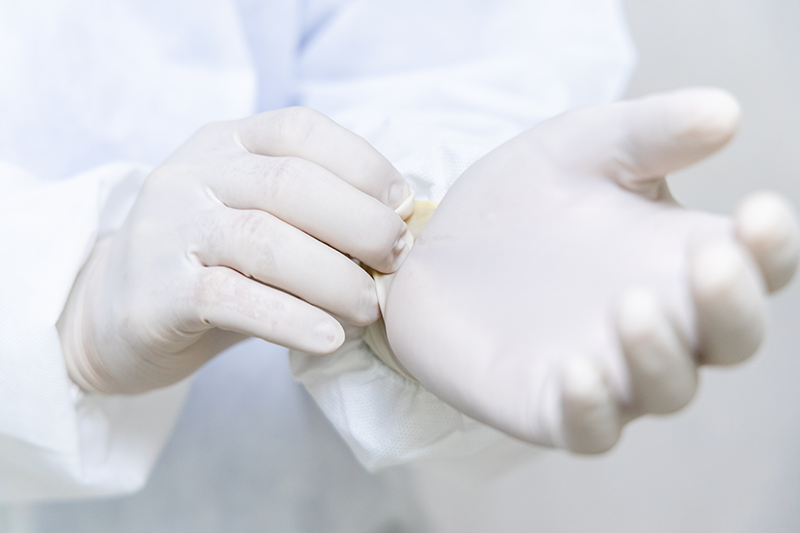When buying gloves, there is always much data wherever the detail page of the product online or the actual glove package.Most of these data are closely related to the quality of the gloves and the applicable scenarios,as well as the essential elements we need to take into account when choosing gloves. Now, follow us to interpret the common data of gloves.
AQL
AQL means Acceptable Quality Level, which is used to assess whether product quality meets specified standards. The AQL of gloves generally refers to the worst allowable process average quality level when a continuous series of batches of gloves is submitted for acceptance. The AQL test of gloves includes width, length, grammage, and pinhole rate. Pinhole inspection is one of the most important aspects of glove quality inspection. The AQL value on the product package generally refers to the pinhole defects of the gloves as well.
The smaller the AQL value, the higher the quality requirements. For gloves quality, the lower the AQL value, the better the barrier and protection of gloves. In addition, the pinhole standard for all medical grade gloves must be less than or equal to AQL 1.5.
Thickness
The thickness of gloves usually refers to the thickness of the palm and relates to the protection and grip of the gloves.
In general, glove thickness is usually measured in mils, where 1 mil is 0.001 inches. Different standards have different requirements for glove thickness. European and American standards require gloves to be between 2-3 mils (palm thickness ≥ 0.05mm). Chinese standards require gloves to be greater than 3 mils thick (palm thickness ≥ 0.08mm). Some gloves also require a high gram weight, usually greater than 4 mils (palm thickness ≥ 0.1mm).
Different industries can choose gloves with different thicknesses according to their needs. Gloves with smaller thicknesses are relatively inexpensive to produce. They not only have excellent tactile sensitivity and grip, but also easy to put on and take off. However, they are less resistant to punctures and tears. These gloves are suitable for tasks that require high precision and frequent glove changes, such as in the beauty and food industries. Thicker gloves are excellent in terms of puncture and chemical resistance. At the same time, they are less flexible and difficult to remove. They are ideal for automotive and industrial applications where tools and high protection are involved. Gloves with a thickness of 8 mil or more are mostly highly resistant to chemicals.They are mostly used in the biopharmaceutical, medical or chemical industries,such as KINGFA fentanyl resistant nitrile gloves.
Tensile Strength and elongation
Tensile strength and elongation are important characteristics when considering the quality of gloves. Tensile strength evaluates the strength and durability, while elongation at break evaluates the elasticity and flexibility of gloves.The ASTM standard provides consumers and glove manufacturers with a standard for evaluating the strength and elasticity of gloves. It specifically specifies the minimum tensile strength before and after aging as well as the minimum elongation of gloves made of different materials. Latex examination gloves have a minimum tensile strength of 18 MPa before aging and 14 MPa after aging while nitrile examination gloves have a minimum tensile strength of 14 MPa before and after aging.In terms of elongation, latex gloves have a minimum elongation of 650% before aging and 500% after aging. And the minimum elongation of nitrile gloves was 500% before aging and 400% after aging.
In addition, tensile strength and elongation of gloves usually need to be considered together.
We need to find the balance between tensile strength and elongation of gloves according to different application scenarios and specific needs to choose the most suitable gloves.
SAL
SAL, or Sterility Assurance Level, is an indicator used to measure the risk of microbiological contamination of sterile products. The manufacture and use of sterile products is important in a number of industries, espcially in the pharmaceutical and medical device industries. When manufacturing sterile products, the process of sterilisation is usually required. The SAL is used to verify the effectiveness of sterilisation. Its value is the probability of each product unit being contaminated after the batch has been terminally sterilised.The SAL provides a concrete reference to ensure the sterility of products and greatly improves the quality of sterile products. As far as gloves are concerned, sterile gloves are mostly medical surgical latex gloves.
Generally, SAL is expressed in the form of an index,such as 10-1, 10-2, 10-3... If the SAL is 10-6, it indicates that one out of every million product units may be contaminated with microorganisms. Therefore, a smaller SAL means a lower risk of microbiological contamination.

Cleanroom Classes of Cleanroom Gloves
When it comes to cleanroom gloves, there is also the classification of cleanroom levels. A cleanliness level is a classification standard used to measure the amount of airborne particles in an environment. It is usually defined using ISO standards. They are usually set by international or national standardisation organisations. The cleanliness levels of cleanroom gloves currently available on the market are defined according to the standard ISO 14644. This standard is primarily concerned with the number of particles contained in the gloves. Cleanroom gloves are commonly used in medical, scientific research, electronics and other industries that require cleanrooms and have high cleanliness requirements.
Cleanroom gloves are commonly classified as ISO 4 (Class 10), ISO 5 (Class 100), and ISO 6 (Class 1000). The smaller the value of ISO, the higher the cleanliness level of the gloves.ISO 5 or higher are used in high cleanliness cleanrooms. They contain less than 1,200 particles and can be used in a variety of clean environments. ISO 6 gloves are used in general cleanroom environments and contain more than 3,000 particles
All the information contained in this article is for general reference purposes. Kingfa Medical does not guarantee the accuracy, relevance, and timeliness of any information, and the company does not assume any responsibility for errors or omissions in this article.




